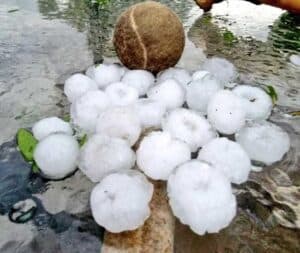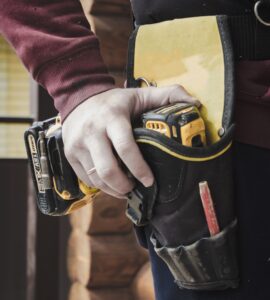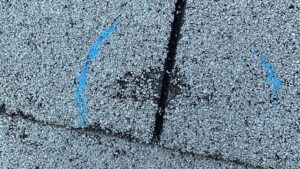The winter months can be very challenging for roof structures. During this time, the elements, from the snow to the ice, can cause significant damage. A blanket of snow on the roof may look pretty, but it is putting a significant amount of strain on the structure itself, putting your people at risk. You cannot control the snow, but you should know how to get help when there are concerns (and you should know how to spot those concerns as well).
What Could Happen to your Roof During the Winter Months?
The type of damage your roof is at risk for during the winter months depends on where you live. However, throughout the country, it is important to pay attention to your home’s needs during this time. There are a few key areas of concern to pay close attention to throughout the season.
Ice Dams
An ice dam is one of the most common and biggest concerns when it comes to roof safety during the winter months. If you have large icicles hanging from the edge of the roof or the eaves of the home, this indicates a big problem. A snow-covered roof and freezing weather create these solid icicles. But they also create ice dams as well.
Ice dams are big thick ridges of solid ice that build up along the eaves of the roof. They can cause damage to the shingles of the roof, pull down the gutters, and even cause the backup of water into the home. Sometimes ice dams form under the shingles, creating pockets of moisture that, when it rains, can seep into the home’s roof and cause significant damage there, including leaks from the roof. Ice dams can create sagging ceilings, warped flooring, and peeling paint, among other problems, in your attic alone.
Don’t try to remove ice dams once they are in place by climbing up and pulling on them or striking them. This will not help to remove them and could increase the chances of you suffering an injury. Don’t put salt on them either, as this isn’t likely to make a significant difference, and it could cause damage to the plants.
A prevention tool like the use of heated cables and heat tape could help if you installed it prior to the start of the season. This works to melt the ice and keeps it from freezing, allowing the water to move away from your structure. If you do have ice dams present, be sure to check the roof and attic space of your home diligently once they thaw and melt to help you to spot any water damage they cause early on. This is the best way to protect your roofing structure.
Snow Load
The snow load of your roof is a very important factor if you live in an area that gets a significant amount of snow. Fresh snow weighs as much as three pounds per square foot. This is the type that is light and tends to be fluffy. Heavy, wet snow can weigh as much as 21 pounds per square foot. While the light, fluffy snow may be okay for most roof structures in good overall condition, that is not likely to be the case for heavy snow, especially if you get more than a few inches piled onto the structure.
It’s not always safe to try to remove a heavy amount of snow from your roof on your own. If you have fears of the roof collapsing due to the weight, such as on an older structure or a roof that you know needs repair, call a roof technician out to help you. Many have specialized equipment that can help to reduce the amount of snow on the roof without putting you at risk.
It’s hard to avoid this risk, especially when a snowstorm occurs. However, the use of heat tape or rope on the roof structure may help in some areas. It helps to melt the snow as it hits the roof. They could provide some elimination of risk to the structure.
Gutters Filling with Debris
Many homeowners take the time to clean out their gutters at some time during the fall months. That’s important because this is the most likely time of the year for gutters to fill with debris. However, debris can still get into these areas after you’ve cleaned them. This is one of the best reasons to install gutter guards, as it will help to eliminate this problem early on.
However, if your gutters are filled with debris now, it is very important to be careful if you are trying to remove them. Doing so puts you at risk for an accident. You can try to remove material from the gutters on a dry day when there is no risk of slipping. Consider a professional service to help you with this process as well.
Gutters Filling with Ice
Gutters fill with ice typically because there is a blockage present. This causes the water to back up instead of flow down them. When this happens, it causes ice to build up, and, eventually, items like twigs and leaves back up further, causing the gutters to build up with a significant amount of ice. This, along with the freezing temperatures, makes it impossible for water to flow over time.
When you have gutters that are like this, do not put salt on them directly as this will not help in most cases, and it can corrode the gutters. What you can do, if you need to get them flowing, is to use hot water or a roof rake to help you get them freed back up.
Heat Loss
Another concern for most homes during the winter is heat loss. This can happen for many reasons, including damage to structures in the home. Heat loss often comes from air leaks or small spaces throughout the home that allows heated air to escape.
Windows
Windows are a common cause of heat loss during the winter months. If the windows are closed and locked, they could still be allowing air leaks if the seals around the windows have even small gaps. You can spot these by running your hand along the interior and exterior of the windowsill. If you feel any cold air, that could be an indication of a leak that needs sealing.
Doors
The same is true about doors. Small amounts of air can escape if a door is not properly sealed. Another way to check for leaks on doors is to wait until night and then have a person stand outside the door with a flashlight. Move the flashlight along all seams of the door, including any window frames. If you see light come through, that means there’s also an air leak here.
Roof
Air leaks can also occur on the roof. Though it is not safe to look for them on the roof, if you have an attic space, you can do so. Again, look for areas where light is peaking through the roof shingles. This could indicate a concern. Be sure to have your roof inspected for missing shingles or structural damage by a licensed professional.
Pay close attention to these areas. Being proactive about them could help you to avoid any type of financial loss during the winter months due to these structural concerns.





